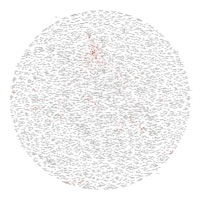MAGDELAINE FAURE
The most connected person in Angoulême in 1764 – or the person in the parish records with the most edges, or connections, to other people – was Magdelaine Faure, a 21-year old woman from the quayside parish of St Jacques de l’Houmeau. She was married in October 1764 to Jean Roy, a bookbinder; nineteen people signed the record of their marriage. She was connected, or sociable, on other occasions as well. She was the godmother of the daughter of a stone cutter in September 1764, also in St Jacques; she signed the record of the baptism of the daughter of an oven-keeper in the central parish of St Paul, in October; in November she signed the record of another baptism, in St Martial.
Magdelaine Faure lived amidst exchanges of information and industry. Her father was a messenger, travelling between Angoulême and Bergerac, in the Dordogne; he had earlier been a letter carrier in the messenger service between Angoulême and Bordeaux. Her sister, Luce Faure, was a carpet-maker. Her husband was a tool-maker before he became a bookbinder; her brother-in-law (who was the husband of her sister Marguerite, as well as the brother of her husband) was successively a cooper, a packer, and a bookbinder. She and her sisters were sociable, literate figures, and frequent signatories in the different parishes of the town. In 1760, when she was 16, she and her future husband were godparents in the parish of St Paul; Luce Faure also signed the record, at the age of 12. All three sisters signed the baptism record of the son of an apprentice messenger in May 1765, in St Jacques. Jean Roy was the godfather and Luce Faure the godmother; Magdelaine Faure was six months pregnant. Magdelaine Faure’s and Jean Roy’s daughter Marguerite Roy was born on August 14, 1765, and baptised the same day, in the parish of St Jacques. She died four days later, and was buried on August 19, 1765. Magdelaine Faure survived her daughter by nine days. She was buried in St Jacques on August 27, 1765, a week after her 22nd birthday.
With all her connections and all her sociability, her friendships and her family relationships, Magdelaine Faure is part of the micro-history of enlightenment in Angoulême, and of the milieu of printers and bookbinders that was so susceptible, for the enlightenment’s enemies, to the seduction of modern times. She is also part of the social history of insecurity. 1764 was a relatively healthy year in the parish of St Jacques, in that there were “only” 26 deaths of infants and young children. The child mortality rate, or the ratio of deaths to births, was 23 percent. Only one woman died in the aftermath of childbirth. In 1765, there were 82 deaths of infants and young children, and a child mortality rate of 77 percent. 12 of the infants born in the parish in 1764 died there the following year; another 5 had siblings who died in 1765. In the dangerous summer months, when the epidemic diseases in the town were most deadly, 6 children died in St Jacques in 1764; 45 children died in the parish in August and September 1765.
Jean Roy remarried in 1767, in the parish of St André. Magdelaine’s mother and sister signed the record. He had nine more children, and founded a dynasty of printers, paper merchants and lithographers.
AM-A, baptism of Magdelaine Faure, GG126/48; marriage of Magdelaine Faure and Jean Roy, GG130/25; baptism of Marguerite Roy, GG130/44; burial of Marguerite Roy, GG130/44; burial of Magdelaine Faure, GG130/45; marriage of Jean Roy and Marie Doraud, GG43/39; signatures of Magdelaine Faure, GG129/9,52,109,157-158, GG130/22,39, GG89/90,108, GG109/186; signatures of Luce Faure, GG129/9,52,109,157-158, GG130/39,44, GG89/90; baptisms and burials of children in St Jacques in 1764-1765, GG130/1-56; marriages of Jean-Jacques Roy (son of Jean Roy) and Jean-Baptiste Durand (grandson of Jean Roy), 1E33/36, 1E76/69-70, and see http://elec.enc.sorbonne.fr/imprimeurs/node/23542 and http://elec.enc.sorbonne.fr/imprimeurs/node/23543.
"I sent some books to my binder, among others the Système de la Nature," Madame La Baronne writes at the outset of the Abbé Barruel's anti-philosophical novel Les Helviennes, published shortly before the Revolution. The binder's apprentice "spent the night leafing through these books, and took some liberties with his master's daughter," to whom he said confidently "that there was no hell, and he had just read it in one of Madame La Baronne's books." [Abbé Barruel], Les Helviennes, ou Lettres Provinciales Philosophiques (4th edition, Paris, 1789), vol. 1, p. 5.
| |
|
Download Data |

